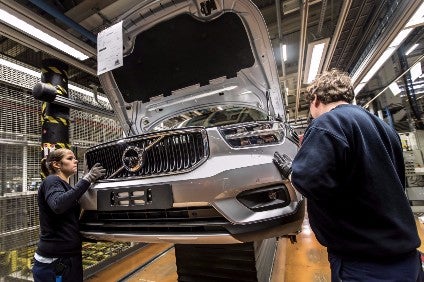Volvo Cars’ claim it was the first car manufacturer in the UK to homologate its entire model range under the new Worldwide Harmonised Light Vehicle Test Procedure (WLTP) was the most-read story on just-auto this week. Timely, as we have been scrutinising WLTP in two special, analysis articles: What does the WLTP mean for the automotive industry? and WLTP prompts responses from carmakers.
All Volvo petrol, diesel and hybrid models now comply with the stringent ‘Euro 6d-temp’ standard for tailpipe emissions, as part of the firm’s model-year 2019 range update which started production in April. VCC also says it puts Volvo well ahead of the 1 September 2018 deadline where only WLTP-homologated cars can be sold in Europe. The aim of the new WLTP cycle is to ensure published fuel economy and emissions – which all manufacturers legally must publish – offer a more realistic reflection of real-world driving, helping customers to judge better the fuel and emission efficiency of their car. WLTP is a laboratory test, and replaces the New European Driving Cycle (NEDC) that can trace its roots back to the 1980s. Both tests enable customers to make comparisons between different vehicles, but WLTP uses a driving cycle that is more reflective of on-road driving.
Close behind, news interest wise, was Ford confirming it was spending up to EUR200m and adding an additional 1,500 jobs to manufacture a second vehicle at its Craiova Assembly Plant, in Romania. The new vehicle is in addition to the EcoSport small SUV currently built in Craiova, plus Ford’s 1.0-litre EcoBoost engine. The model and start date for production of the second vehicle will be confirmed closer to launch. Ford did make the B-Max small MPV at Craiova, a one-time Daewoo plant, but that model was discontinued last year after disappointing sales. The new model to be made at Craiova is likely to be the Ka+ which is selling well in Europe and currently imported to the region from Sanand, India. B-Max was originally sourced from India, too.
This week, we spoke to Thilo Bitzer, senior vice president, steering engineering, ZF active and passive safety division, about steering systems for AVs as well as active front steering and dual-pinion electric power steering systems. We also took a look at future EV and SUV plans by Dongfeng Motor and Nissan Motor’s Venucia, a brand which concentrates on low price vehicles for China.
Trade spats and tit-for-tat continued with the news China is to cut its import duty on passenger cars to 15% from 25%, effective from 1 July. It currently charges an import tariff on finished vehicles of 25%. Such tariffs have encouraged OEMs to set up JVs in China and localise parts sourcing as much as possible but many have complained that they have little control of their Chinese JV operations and warned of intellectual property abuses and pressures to transfer technology. Rising trade tensions between the US and China have subsided in recent days, with moves to raise new tariffs by both countries ‘put on hold’ while they work on a new trade agreement.
Next, after a curious presidential tweet, came news the Trump administration is considering a plan that would impose new tariffs – as high as 25% – on vehicles imported to the US on national security grounds. President Trump already has used the Section 232 legal provision to provide justification for tariffs on imported steel and aluminium. But he is now considering starting a probe of imported cars under the same law. Trump said the US car industry was “critical to our strength as a nation” and ordered the Department of Commerce to investigate. The probe rests on decades-old legislation which lets the president restrict imports if they threaten national security. Hefty tariffs on imported cars would likely face considerable opposition from manufacturers – such as BMW and Mercedes – with manufacturing plants in the US, as well as US dealers who sell imported brands.
Finally, 48V technology continues its advance as Kia announced its updated Sportage, out later this year in Europe, will be the brand’s first to be equipped with a new ‘EcoDynamics+’ 48V diesel mild-hybrid powertrain. Kia claims it is the first manufacturer to offer hybrid, plug-in hybrid, battery-electric and 48-volt mild-hybrid technology across its full model line-up and will launch 16 advanced powertrain vehicles by 2025, including five new hybrids, five plug-in hybrids, five battery-electric vehicles and, in 2020, a new fuel-cell electric vehicle. The Sportage mild-hybrid technology features a 0.46 kWh 48-volt lithium-ion battery and a new Mild-Hybrid Starter-Generator (MHSG). By electronically controlling the MHSG using the inverter, the system switches between two modes: ‘motor’ and ‘generator’. Connected by a belt to the diesel engine’s crankshaft, under acceleration the MHSG provides up to 10kW of electric power assistance to the powertrain in ‘motor’ mode, reducing engine load and emissions. In ‘generator’ mode, the system harvests kinetic energy from the vehicle during in-gear deceleration and braking and uses the power to recharge the batteries.
Have a nice weekend.
Graeme Roberts, Deputy Editor, just-auto.com







